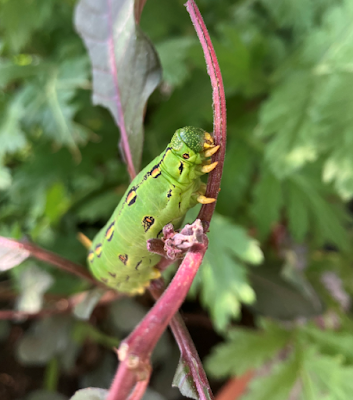posted by: John Murgel, Douglas County Extension
National Pollinator Week officially ended yesterday, June 23—and
I celebrated by stumbling across the largest caterpillar of the season so far! In the quiet of a Sunday afternoon in the
dappled shade of the trees near the house, I settled in to read a book.
The usual sound of bumblebees ponderously pollinating nearby
was punctuated by a rhythmic clicking.
Putnam’s cicadas? No…not quite
right for that. Looking around, I was
suddenly struck by the absence of one of my prized fuchsias, and shortly
thereafter by the cause of the absence.
My consternation was tempered by astonishment. A four-inch-long hornworm perched on what
remained of the fuchsia, vacuuming down leaves with steady dedication. The clicking? The sound of my fuchsia’s
demise as the giant (relatively speaking) mandibles did their work.
The ornate culprit was a fully grown larval Hyles lineata,
or white-lined sphinx, one of the “hummingbird moths” that are common in
Colorado gardens. They have a wide host
range, including purslane (Portulaca), evening primrose (Oenothera),
grapes, apples, and others along with my poor fuchsia (proving that, at least
sometimes, plants need not be “native” to host the caterpillars of native moths
and butterflies).
The white-lined sphinx has two generations per year, and
probably colonizes Colorado each summer from warmer winter climes. This caterpillar (murderous fiend! My fuchsia!) will pupate underground, spending
two or three subterranean weeks before emerging as an adult. Hopefully it will have the decency to
pollinate something in the yard before starting the cycle over again.
Hornworms are among the most common caterpillars in the
United States, and most species develop in trees and shrubs, where their damage
isn’t noticed. Only the tomato- and
tobacco hornworms are typically considered “pests,” though with the expansion
of the European Paper Wasp in urban and suburban Colorado, even these are
rarely problematic for Front Range gardeners.
I watched the caterpillar, and of course called the kids
outside to see it. Because I
deliberately garden for invertebrates (especially the cute ones) I was, in
reality, happy about the caterpillar, even if annoyed by the disappearance of
the fuchsia (was there not enough purslane?!).
The interaction highlights one of the trade-offs of “pollinator
gardening,” that is, some of the plants are going to be eaten. Deliberately choosing to accept this damage
as the expense for having desirable insects around comes with the territory. Had the caterpillar been less mature, I might
have moved it to a different host plant.
As it was, after polishing off the fuchsia, it lumbered off, likely to
find somewhere to dig its pupation chamber—and I was off to the garden center.



No comments:
Post a Comment